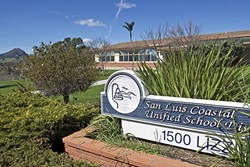The Diablo Canyon Nuclear Power Plant won’t officially shut down until 2024-2025, but the San Luis Coastal Unified School District (SLCUSD) isn’t wasting any time preparing for the looming reality of losing $8 million per year in property taxes from the outgoing plant.
On Feb. 21, the SLCUSD board of trustees unanimously signed off on a plan to shave $2 million from the district’s budget in 2017-2018. The cuts include reducing district support for teachers wrestling with new Common Core curriculum, eliminating school resource officers at high schools, and ending a program that offered one-on-one help to students behind in reading.
“The sooner we make these reductions, the less painful it will be down the road. That’s the philosophy here,” SLCUSD Superintendent Eric Prater told New Times.

- PHOTO BY JAYSON MELLOM
- DOWNSIZING: The San Luis Coastal Unified School District faces deep budget cuts due to the closure of Diablo Canyon Nuclear Power Plant, which brings $8 million per year to the district in property taxes.
The cuts mark the first, and likely least controversial, reduction in a series of tough budget choices that lie ahead for Prater, the school board, and the community. To bring the district into equilibrium with post-Diablo Canyon revenues, the district has to reduce expenses by about 10 percent. The rising cost of pension programs like CalPERS compounds the district’s financial dilemma.
In confronting the cuts, SLCUSD is following some guiding principles discussed in a series of public forums in the fall: Make cuts sooner rather than later; start slashing furthest from the classroom; focus on reducing personnel costs; and utilize retirements and resignations to minimize layoffs.
That blueprint is visible in next year’s budget. The SLCUSD finds cost savings in relocating the district’s Instructional Media Center on Southwood Drive, which houses curriculum materials and services teachers and students district-wide. The center will move to the main district office, and its library technicians will be reassigned to individual school libraries. The district is saving about $200,000 by nixing contracts with local police departments for school resource officers and eliminating a “noon duty” supervisor position at SLO High School. Prater is also consolidating a few jobs in the district office, and laying off three employees, including an instructional aide at Morro Bay High School.
Even though next year’s reductions avoid the most contentious issues like classroom size and school size, the cuts are nonetheless a loss for the SLCUSD community and its mission, said Craig Stewart, a SLO High English teacher and the president of the San Luis Coastal Teachers Association.
“Everything the district is cutting is valuable to teachers and students, all the way up to district office staff,” Stewart told New Times. “The SLCUSD exists to educate the children of our community, and every lost dollar detracts from that purpose in one way or another.”
More than $700,000 in cuts to professional development and instructional coaching particularly pose challenges because the SLCUSD is in the middle of transitioning to new state-adopted Common Core curriculum. The transition to Common Core for mathematics, which the SLCUSD did a few years ago, turned out to be a bear for teachers, Prater said. A robust teacher development program helped ease the growing pains. Now, as the SLCUSD readies to adopt the remaining Common Core subjects, it will have to make the switch with fewer resources.
“[Common Core] is a new way of teaching, it’s a new way of thinking, and it’s difficult,” Prater said. “While still transitioning to Common Core, I’m having to reduce the engine that allows that transition to occur successfully.”
The budget reductions for 2017-2018 also include eliminating a position that helped connect struggling families with social services, as well as an instructional program called “Transition Reading Recovery” that provided one-on-one support for first grade students behind in reading. A less-costly model, “Leveled Literacy Intervention,” offering small group sessions, will take its place.
With the 2017-2018 budget set, the SLCUSD now turns its focus to the longer term, where even tougher decisions await. Prater indicated that the next cuts are likely to cause more heartache for the community.
“Ultimately, it’s going to involve people losing their jobs or our programs being lost,” Prater said. “How else do you cut $8 million?”
Prater is in the process of assembling a Blue Ribbon Committee, a coalition of non-district-employed community members handpicked by Prater who in the coming months will intensely deliberate the SLCUSD’s long-term strategies. In the fall, the Blue Ribbon Committee will produce a multi-year budget plan recommendation for Prater and the board to consider.
“I’m going to get this [Blue Ribbon Committee] started and then I’m walking away from it,” Prater said. “I want a fresh set of eyes on the problem. Maybe I haven’t thought of something.”
Whatever long-term strategy the SLCUSD adopts will no doubt depend on the outcome of a tentative agreement between PG&E and the SLCUSD, SLO County, and six cities awaiting approval by the California Public Utilities Commission. If the current deal stands, the SLCUSD would receive about $36 million from PG&E to mitigate the impact of the plant closure.
Prater is on pins and needles waiting for the state’s decision.
“That money is critical on so many levels,” Prater said. “If that money gets held up, then of course it’s a different strategy.”
Prater himself is tied up in district funds. He accepted a $950,000 home loan from the school board in December that brought about criticism from the community. Prater said he wants to prove his value by successfully leading the SLCUSD through the Diablo Canyon crisis.
“It’s a loan and it’s a strategic decision by the board and me to maintain a mutual interest,” he said. “If I do my job well, it will prove that this was a good decision.”
You can reach Staff Writer Peter Johnson at [email protected].
Comments